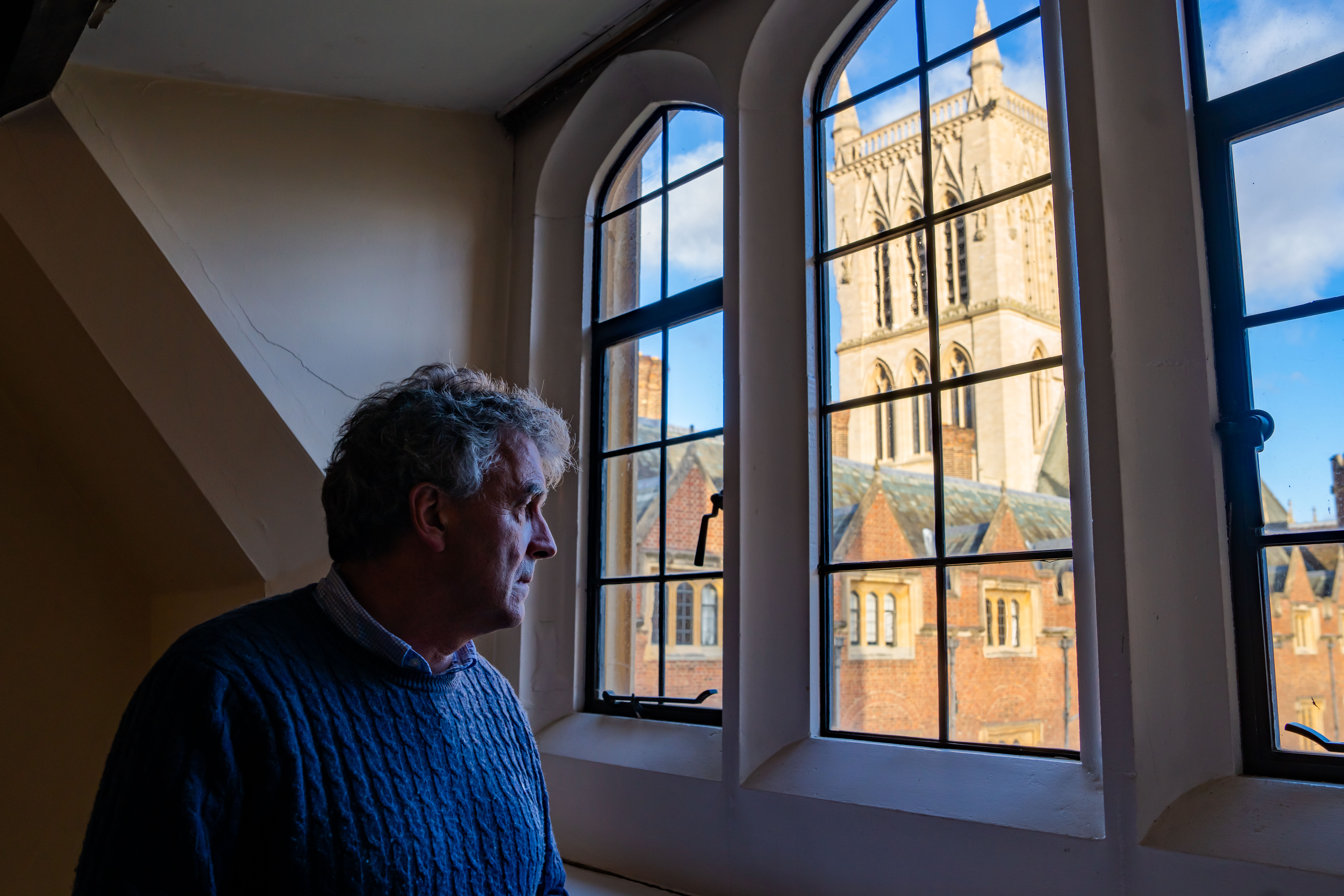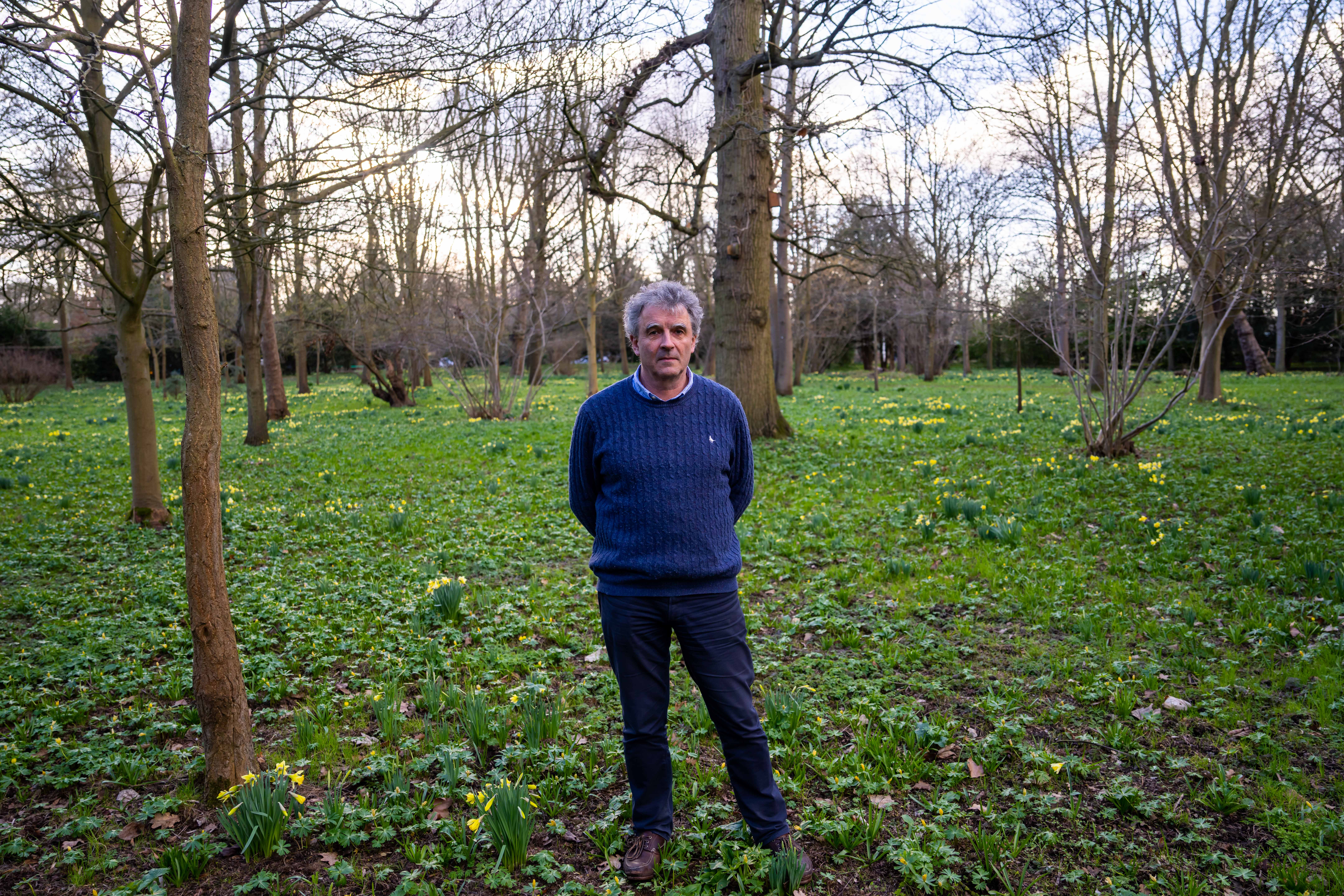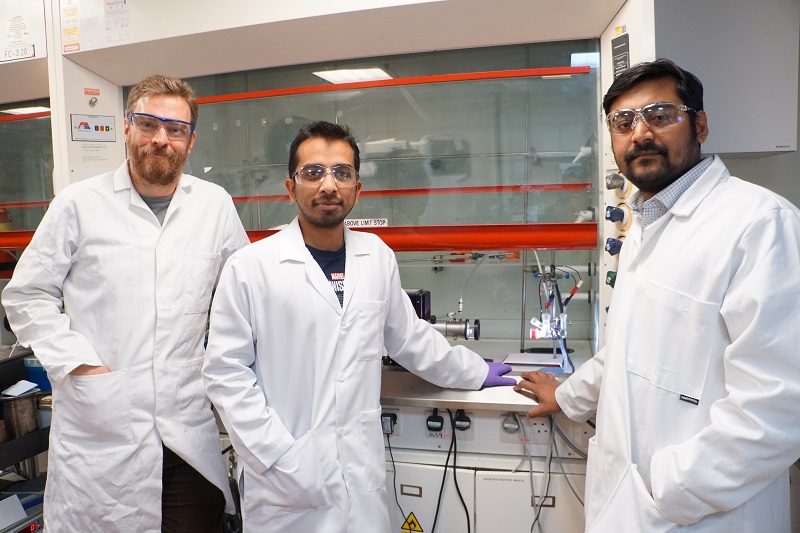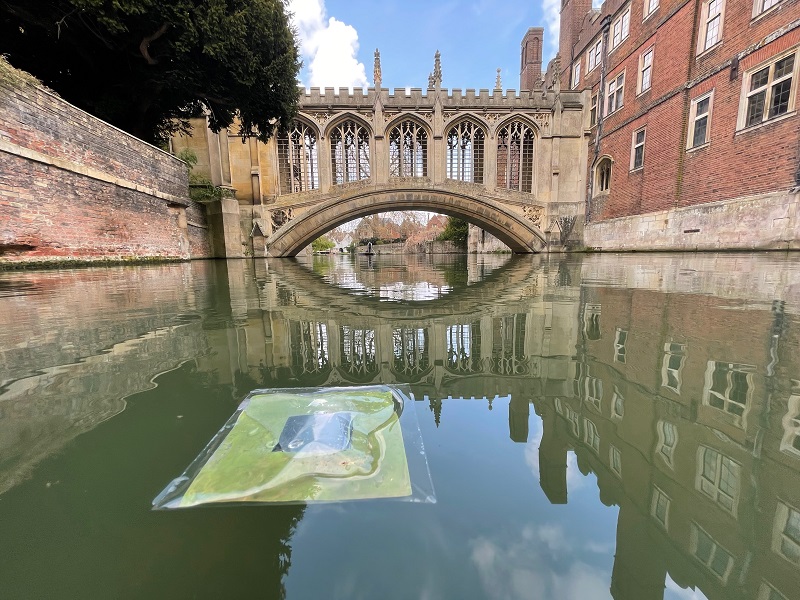Energy
Green light
Green light: St John’s launches new project exploring theme of energy in research and College life
Energy – its sources, impacts and transitions – is one of the key issues of our age. How we eat, how we keep ourselves and our buildings warm, how we counter the destructive effects of carbon emissions on our climate as we transition to cleaner energy: all are challenges every country, institution and individual must engage with. A Cambridge college, even one built centuries before the industrial revolution, is no different. Here at St John’s, just like the wider University, we are grappling with these unprecedented questions, in our world-leading research but also in our day-to-day processes as a place of study and a residential community.
Today we begin a series of articles on the theme of energy that will span topics from the latest solar fuels research – spearheaded by one of our Fellows – to the sourcing of the food in Hall, from the challenges of flying and computing to reflections on heating and energy use throughout the College’s (often drafty) 500-year history. We’ll discover how our own academics are exploring an array of energy-related issues: not only engineering solutions for cleaner, sustainable power and fuel as we move towards net zero but also geopolitical perspectives on energy and international development and the long views of historians tracing the origins of the industrial change that led ultimately to the present climate crisis.
We begin, as perhaps all energy discussions should, at home. At St John’s, we have our own manifesto, adopted in 2019, setting out the steps we will take as a community to reduce our own greenhouse gas emissions significantly by 2030 and aiming to reach net zero before 2050, the deadline pledged by the UK government. Here, we lift the lid on the action we are taking to ensure our historic buildings meet the environmental demands of the 21st century.
Not just hot air
Not just hot air: bringing sustainable heating to a 500-year-old College
“The doors leak, and so do the windows,” says Professor Andy Woods, sitting in his St John’s study beside a gas fire that is, despite the chills of February, turned firmly off. “These are historic buildings: they are poorly insulated and take a lot of heating, so they are very challenging to decarbonise. Also, Cripps [John’s’ 1960s Modernist accommodation block] has a huge amount of glass.”
Fortunately, Andy – chair of the College’s Energy Transition Working Group – is precisely the right person to take on that challenge. The St John’s Fellow is Director of the Institute for Energy and Environmental Flows (IEEF) established in the University of Cambridge in 2000 and originally known as the BP Institute. IEEF researchers work with academic and industrial collaborators from around the world, using fluid mechanics, thermodynamics and surface science to help with some of the major challenges of decarbonisation, including geological carbon storage, geothermal heat storage, energy efficient building design, and superfast battery charging.
The Institute is at the forefront of global energy transition research, but through the St John’s project, Andy and his team can also apply their expertise locally in the complicated context of a 500-year-old College estate on the banks of the Cam in the fast-growing, energy-hungry city of Cambridge. “In these challenging buildings,” he says, “there is not necessarily a template for how you go about doing this. We’re trying to understand what can be done, and comparing different approaches. We’re carrying out research on the design and operation of low carbon and energy efficient heating systems for College, looking at the challenges of deploying such systems in important historic buildings.” With the College as a test bed, the hope is its experience can be shared as widely as possible to help others in the UK and beyond.

To achieve the agreed goal of reducing the carbon emissions of the College, transforming the heating was the clear first step. On the St John’s estate, over 80% of carbon emissions come from burning natural gas to heat the buildings and provide hot water. There are no fewer than five giant boiler systems on the main College site, while student hostels (mainly a collection of individual houses) have their own independent heating systems. Currently, the College uses about 12.6 gigawatt hours of gas annually for heating its buildings and water, at a cost of approximately £882,000 per year.
“If you can remove the natural gas, then you’re not getting those emissions,” Andy says. “But you have to replace the gas with something. So, you can put heat pumps in: they take thermal energy from one place, raise the temperature of this energy and use it to drive the central heating. But you need electricity to run the heat pumps. One unit of electrical power in the pump can transfer three units of heat to the radiators. So, we asked, can we use heat pumps in College?”
The working group developed models to explore options including high and low temperature heat pumps, powered by air source or ground source heat supply, and identified the costs, practicality and efficiency of each. The analysis concluded that replacing gas boilers with a series of heat pumps would cut the College’s carbon emissions by at least half, and possibly by as much as 55%. The pumps would not remove emissions completely because the electricity that powers them is drawn from the national grid, and – while the proportion of electricity generated from renewable sources is growing – gas-fired power stations still play a role. In the longer term, as the national electricity supply becomes progressively more decarbonised, so will the College.
The next step is to move from calculations to real-life trials. An air source heat pump will shortly be commissioned to power two staircases in Cripps, and further heat pump systems will be introduced into some of the houses on St John’s Road. If successful, the provisional longer-term plan, which will cost an estimated £20 million plus the cost of supplying new electricity, will see high temperature pumps used to heat the buildings of the main College estate (many of them old and listed in recognition of their architectural and historic significance), while the newer hostels will be fitted with lower temperature versions.
While the heat pumps will make the most dramatic single impact on its emissions, there are other important steps the College will also take, Andy says. “We have a three-point plan, and heat pumps are only the first part. We also need to have more precise control of energy use. We are developing prototypes for a digital system that will allow us greater control and save money.” There is scope, for example, for a smart system that would turn off radiators remotely when students leave for the Christmas holiday, and for introducing temperature and motion sensors to enable heating to switch off automatically in individual rooms if a window is opened or the room is unoccupied for a long period.

The third element in the energy saving plan is the upgrading of the fabric of the College buildings to improve insulation and reduce heating demand. The process is effective, but expensive: increasing the insulation in two student houses alone cost more than £100,000. “It reduced the gas bill by 50% but the payback time is very long,” Andy notes.
If the heat pump trials prove successful and the approach is extended College-wide, there will be more hurdles to cross. A test programme will be needed to decide on the balance between air source and ground source heat for the main College heat pumps, and locations will need to be found for the technology needed to operate either system. Air source pumps require heat exchangers; heating the whole College would need an area of many hundreds of square meters. Roofs of newer buildings could potentially be used, but there will be design challenges to address. To use ground source heat, meanwhile, the College would need many hundreds of boreholes, each up to 150m deep. The holes could be drilled on the College backs, but space is limited and to work effectively they cannot be placed too close together.
A third – and intriguing – potential heat source in winter is the River Cam, either through heat exchangers within the flow or by extracting water, cooling it and returning it to the river. St John’s is collaborating with the other seven Colleges sited directly on the river to scope out the possibilities of the scheme, and work has been underway for the past six months to test the river flow and temperature. The project seems viable, but – even if the relevant permissions are granted – the energy produced would be shared between the Colleges along the Cam and could only contribute a portion of John’s’ overall demand.
Even once the technical challenges of designing and installing heat pumps have been overcome, a wider structural issue remains: Cambridge has an electricity capacity problem. There is, for now, too little electricity supplied to a city with growing demand, including electric vehicle charging. “You bump up against the infrastructure of what is actually possible,” Andy says. “If many of the central Colleges were to install heat pump systems, we would need tens of megawatts of additional electricity supply, as well as the increasing demand from the university. There is competition for resources. Until the grid builds up and there is more supply, it’s going to be hard to do this.” Even once there is enough electricity, the supply of skilled plumbers and engineers to install the new system may not be able to keep pace with demand.
The obstacles in decarbonising a College, clearly, are many, but developing strategies to overcome the various problems, Andy adds, is the point. “Publishing our approach to decarbonise such important and historic buildings in the academic literature could be very valuable in helping inform strategies on decarbonisation of other challenging or historic buildings and institutions. There’s a wide variety of building types in St John’s and there is not a one-size-fits-all solution.” The working group has already shared its findings with building estate managers of other colleges and plans shortly to issue a publicly available report on its progress.
The John’s experiment is small in global terms, but great in its potential to act as a beacon for others. One by one, the many technical and other challenges can be overcome, using Cambridge expertise, Andy says. “I’m very optimistic we can trial many approaches and technologies and make a big change. It’s a really exciting time.”
Professor Sunshine
Professor Sunshine: the blue-sky thinker using solar energy to create green fuels
In the second article in our St John’s energy-themed series, we meet Professor Erwin Reisner, whose innovative Cambridge research team harnesses sunlight to turn trash and CO2 into sustainable fuels. He explains why he chose this challenge, and reveals the balance between working for the greater good and day-to-day problem solving in the Lab.
At the start of 2023, a year promising no let-up in the threats facing the planet, Professor Erwin Reisner and his team at Cambridge’s Yusuf Hamid Department of Chemistry published a paper whose findings seemed almost miraculous. A reactor developed by the researchers could, they revealed, transform both plastic waste and greenhouse gases into sustainable green fuels and other valuable products, powered solely by energy from the sun.
The system, the journal Nature Synthesis reported, would be the first solar-driven reactor to convert two different types of waste – which happen to be two of the biggest threats facing the natural world – into two beneficial chemical products at the same time. It would convert carbon dioxide into syngas – a synthetic gas used to make green liquid fuels in place of oil-derived petroleum and kerosene, while plastic bottles would be turned into glycolic acid, widely used in skincare products.
It sounds almost too good to be true, yet it isn’t. The system, with the potential to be a game-changer in the development of a circular economy, is exactly the kind of product the Reisner Lab, and particularly the Cambridge Circular Plastics Centre (also led by Erwin), were set up to create: it combines imaginative blue-sky thinking with practical measures hammered out through careful research. “Our job as academics is to create and promote new solutions and technologies,” says Erwin, Austrian-born Professor of Energy and Sustainability at Cambridge and a Fellow of St John’s for 13 years. “My privilege as an academic is that I can be a dreamer and a visionary and have the time to develop new ideas and systems.”

Erwin, who leads a 25-strong lab made up of half PhD students and half postdocs, focuses his research on sustainable fuels rather than green electricity generation. “We are not interested in electricity generation; for me, as an academic, that is done. Hydrogen is also done, I don’t think it needs me.” Electricity, he points out, represents only a fifth to a quarter of energy demand globally, while the rest is supplied by fuels that must be made renewable if global decarbonisation targets are to be achieved. His particular target is “the difficult last 10 per cent” of fossil fuel use that will not easily switch to sustainable sources, mainly in the oil-guzzling transport and chemical industries.
The lab’s journey to developing the twin waste reactor began with work on converting the greenhouse gas carbon dioxide, or CO2, into syngas using solar power. The researchers developed a ground-breaking ‘artificial leaf’– an ultra-thin flexible device taking its inspiration from plant photosynthesis. Light enough to float on water, the leaves use just sunlight, carbon dioxide and water to create syngas, raising the prospect of clean fuel generation at sea to serve shipping or remote island and coastal communities.
Alongside the water-based trials, the team experimented with biomass waste – non-edible plant or animal waste such as grass clippings, manure or paper – and found that, too, could be broken down to produce clean fuel. Finally, by accident, Erwin’s researchers discovered that the system worked on plastic waste, which would otherwise end up in landfill. “We analysed a failed experiment and found this by chance,” he says. “This is also why academic freedom is so important, and being able to spend time on something where it is not clear what the outcome will be… There should be more flexibility to really build something completely novel and innovative. We always look in our science for new applications, unexplored niches where we can deploy our systems.”
Even after devising and proving brilliant new concepts, the next challenge for labs such as Erwin’s is to introduce the technology in the real world. When a solution is already available, like the cheap production of hydrogen from natural gas, it can be hard to break in – even for a green replacement for a fossil technology. “Our commercialisation ambitions are affected by this,” says Erwin, “but I recognised it early and we’re now very close to having a start-up company. Perhaps it’s because we were pushed so hard by the constraints of the existing energy industry that we produced two products in one device. We needed to be imaginative in our thinking to compete with an industry that has been going for 150 years and is completely dominant. It is always hard for small start-ups and new technologies to come in and occupy that space.”

There is, clearly, an urgency to the research of the Reisner Lab and others in the same field in the light of the climate crisis. The effect of that pressure on himself and his team is mixed, Erwin says. “There are two layers. In my own position, I have a responsibility to really look into this and provide potential solutions and develop these technologies. I think they should be tied into societal interests: we have to work for the greater good. So for me, it means making the world a better place, providing sustainable solutions and making sure we don’t boil and eventually end up like a little Venus.
“But day-to-day in the lab we don't really see it. It’s very important to take what we are doing into the real world, but your daily motivation can't be that: you’re just solving scientific puzzles and troubleshooting all day long.”
Back out in the real world, there are ‘huge opportunities’ and economic advantages to breakthroughs like the solar reactor. “This will be where all the future is – the biggest economic opportunity of our century and governments should embrace it fully.” The problem, he notes, is short termism, a ‘hype-bust cycle’ in which funding lasts two or three years, and is then cut. When the public focus fell on ocean plastics after Sir David Attenborough’s 2017 Blue Planet II series, ‘activity and funding exploded in the UK’ to address plastic pollution, but then not sustained again as government priorities moved elsewhere.
To keep the case for energy science in the public eye, Erwin and his team work hard to communicate their work. The lab’s website explains the reactor and other breakthroughs at a variety of levels, including some appealing stop-start Lego animations set in ‘Bricktown’ in which mini-figures make use of renewable energy. Erwin visits schools and ensures he does something ‘outreach-related’ every month. His next venture into public engagement is especially tempting: a ‘Pint of Science’ talk in a local pub.
As for the future, he sees no limit to the possibilities for developing the Lab’s work. “Our dream is to use sunlight to make any chemical you want. Why not to make drugs, pharmaceuticals from CO2? I like the idea of a solar-powered recycling plant where we put all our trash in and out come the fuels or the drugs or the vaccines. And we hope for support to make this a reality.”
Chemists like himself, he argues, have a critical role in ‘showing you can really open a sustainable chemical space and be a ‘clean chemist’.” But alongside such serious goals, there is a lighter side too. “It’s also fun. You’re always learning something new. My research group includes material scientists and physicists as well as chemists and microbiologists: this topic is so broad. I just love my day-to-day routine: solve little puzzles, work with great people, come up with new ideas and think about something good for society too.”